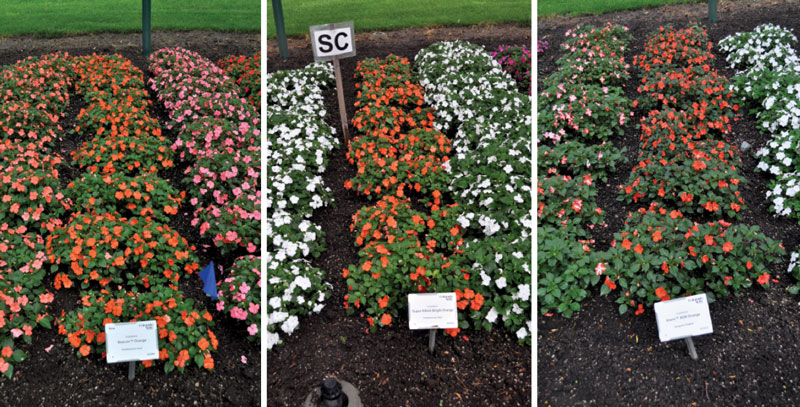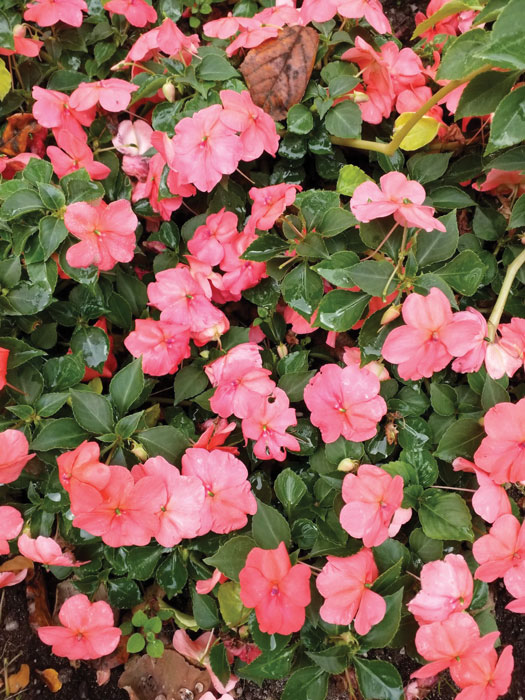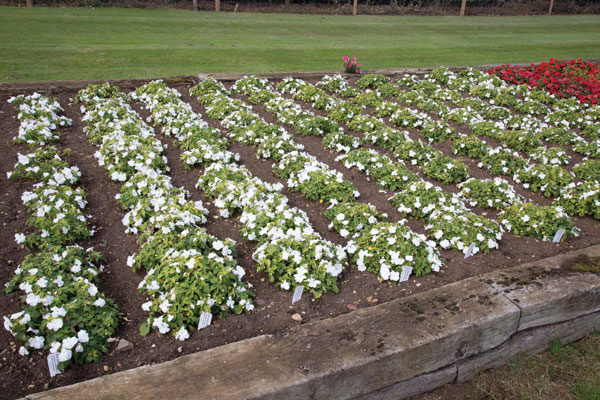10/1/2019
Put Through the Test
Jennifer Zurko

Colorado State University—Fort Collins, Colorado
Trials Manager: Sean Markovic
Planted: All impatiens in our shade area (60% shade) were planted June 5 (Week 23).
Overall performance/Differences and similarities: All impatiens performed well overall. The Beacon series was larger than the Imara series. The flowering of both series was impressive with high ratings across all varieties. Flower color rating system used is 1 to 5, with 5 being totally covered with blooms. All were scored in the range of 3 to 5. These were taken seven times July through September.
Weather conditions: Weather in Colorado was cool and rainy until mid-June and then hot and dry with one hail incident (July 5) that didn’t affect the impatiens because they were under the shade structure for protection.
Final ranking: We had our evaluation day on August 6, with 160 company representatives, green industry members and master gardeners evaluating each variety, getting about 23 evaluators’ ratings. The numbers ranged from 2 to 4 on a scale of 1 to 5, 5 being highest ranking. Overall, these were average rankings for all of our trial entries (1,068 total).
As the coordinator, I’ve seen these plants grow from greenhouse to flower color ratings. The Beacon series grows taller and looks very impressive. It had no downy mildew or other disease present during the summer. The Imara series was just as showy in flower power, but had a smaller habit that really made it look inferior to Beacon until late August when the tight habit and extra blooms made it an outstanding display. No disease was present with Imara either. The Super Elfin “controls” didn’t get any downy mildew either, so I doubt that we had any downy mildew pressure for the series to be subjected to this season.
Pictured: Trials of all the oranges—From left to right: Beacon Orange, Super Elfin Bright Orange and Imara XDR Orange.

Michigan State University—East Lansing, Michigan
Trials Manager: Daedre McGrath
Planted: Both varieties were planted on June 4, 2019.
Overall performance/Differences and similarities: We had problems with flooding due to heavy rainfall early in the season. As a result, both varieties suffered from some type of unidentified lower stem rot (black lesions on lower stem, with defoliation of bottom half of plant). The Beacon series definitely were harmed more by the stem rot than the Imara series, but that could have been due to differences in drainage. Many plants of the Beacon series died as a result. By the end of the season, however, the surviving plants of both series were fairly similar in performance. Neither series is showing any signs of IDM.
Weather conditions: Temperatures were average during both May and June. May had a normal amount of rainfall, but June had double the amount of rainfall (nearly four more inches) than the historical average. We had very low rainfall in August.
Final ranking: We do assign scores for certain criteria for each variety. Unfortunately, Syngenta didn’t officially participate in our trials this year. We grew the Imara series as a comparison for Beacon, but we didn’t evaluate the Imara plants. I can say, though, that overall, the Beacon look better (but that may be due to the flooding/drainage issues).
Pictured: Beacon Coral at the Michigan State trials, which had a rough year, weather-wise.

Penn State University—Lebanon, Pennsylvania
Trials Manager: Sinclair Adam
Planted: Week of May 21
Overall performance/Differences and similarities: Rather close in scores, but Beacon edged out Imara by a bit. One area where this occurred was in uniformity, with Beacon habits being more uniform. Also, Imara XDR Orange Star blooms weren’t stable—some solid color, some the striped form advertised.
Both lines grew well and bloomed well (score 4-plus for flowering in most cases). Imara XDR Salmon scored 4.5 for flowering in all 4 ratings.
Two Super Elfin Impatiens varieties were interspaced with the Beacons. They have both defoliated from the mildew (confirmed by Plant Pathologist Dr. Alyssa Collins, who’s also the experiment station director). Impatiens Rockapulco Orange also in a downward spiral right now due to downy mildew.
Weather conditions: The weather’s been very bombastic. We had 8 in. of rain above average—last year, we had 10 in. above average.
Pictured: Three whites in containers at the Penn State trials—Left: Imara XDR White, center: Beacon White and right: Super Elfin White (showing clear signs of IDM).

Smith Gardens—Marysville, Washington
Trials Manager: Denise Mullins
Planted: Week 16
Overall performance/Differences and similarities: Overall both series performed well. The habits are similar, but Beacon flowered earlier than Imara did by one week or so in pots. However, in the garden, the Imara series looks better and more uniform overall. We don’t have the powdery mildew pressures the rest of the country does. The impatiens are still looking great in our garden. Also, Beacon offers only solid colors and the Imara series has bicolors in their assortment
Weather conditions: June this year was a little on the wet and dark side, but not unusual for us. July and into August the weather has been average and maintained days in the 70s and nights in the 50s with low humidity.
Final ranking: We would give Imara a 4.2 rating with Beacon a 4.0 rating due to garden performance, but neither one of them have powdery mildew!
Pictured: Taken at Smith Gardens’ Open House in June, Beacon (left) and Imara XDR (right).

Texas A&M University—Overton, Texas
Trials Manager: Brent Pemberton
Planted: Week 23
Overall performance/Differences and similarities: The Beacon Salmon, Coral and Bright Red—along with Imara XDR Orange, Red, and White—have shown good season-long averages. Performance is overall landscape appearance (with 1 = Dead to 10 = Being perfect) and flower rating based loosely on percentage of coverage (with 1 = Up to 10% and 10 = Up to 100%). I would say the biggest difference is that the Imaras are a bit more compact and not quite as heavy flowering as the Beacons. However, some colors did better than others in both series.
Weather conditions: June was “mild” with some rain as far as our late spring goes, but August was pretty hot, even by Texas standards.
Final ranking: None of the standard impatiens were in the People’s Picks list this year, but they weren’t at peak flowering on Field Day, as per the late planting. Also, we haven’t seen any downy mildew (even with Super Elfin controls) yet, but I think this is also due to the warmer temperatures with the late planting.
The late planting this year was due to about 20 in. of rainfall in April and May, which really played havoc with field prep this year!
Pictured: Left: Beacon Bright Red. Right: Imara XDR Orange.

University of Minnesota—Morris, Minnesota
Trials Manager: Steven Poppe
Planted: The seed was sown in the greenhouse on March 9 and planted into the display/trial garden the week of May 27.
Overall performance/Differences and similarities: Both series had excellent ratings almost the entire growing season. The Beacon series had a below-average rating as compared to Imara series after transplant in the field in June, but quickly recovered. Throughout the entire growing season, including September, the Beacon and Imara Impatiens are outstanding and equal in performance, vigor and flowering ability.
Weather conditions: May was the second coldest on record. June and July had about average temperatures and August had below-normal temperatures. May through August had all above-average precipitation. Weather records have been taken daily at our experiment station since 1885.
Final ranking: Beacon Salmon was one of our Top Ten varieties for 2019. (Annual flowers are evaluated on unique characteristics, exceptional performance, color and vigor under regional conditions. A visual evaluation and score is given three times during the growing season. Only the highest-rated cultivars earn the distinction of a Top Ten Performing Annual.)
Pictured Left: Imara Impatiens trials bed at the University of Minnesota, with Imara XDR Rose in front. Right: Beacon Salmon.
IDM Outside of the U.S.
If you recall, Impatiens Downy Mildew (IDM) took quite a toll on a few countries around the world before we started feeling the effects here in the States, so they were just as eager (maybe even more so!) to get their hands on the new resistant varieties. I asked three Ball Horticultural Company distributors from three countries to provide their trials results, too, just to see how Beacon and Imara XDR fared in their areas.
Ball Australia—Skye, Australia
Trials Manager: Gideon Cox
Planted: Weeks 37 and 41; Grew six Beacon colours in containers (Editor’s note: Ball Australia doesn’t sell Syngenta products so they only grew Beacon.)
Overall performance: I didn’t have any losses on any of the Beacon … or strangely the Super Elfin. All performed really well. No fungicides used at all for the entire trial.
Impact of IDM in your market: I’m pretty sure that Australia was one of the first places to experience the problem and it made a significant impact on our sales of both seed and vegetative I. walleriana. It gave us an opportunity to promote other products, such as SunPatiens, which have gone really well for us. We have kept selling Super Elfins, etc. because there has still been a demand for the product, but customers have been wary and the total numbers are much reduced from the peak.
We would now like to just drop all I. walleriana except Beacon, but there still remain the issues of inventory, availability, customers who have label stocks, special mixes, etc. But we aim to transition out as soon as we practically can for everyone’s benefit. Another couple of colours added to the range and it will be happy days!

Ball Colegrave—Banbury, England
Trials Manager: Peter Mitchell
Planted: Week 22
Overall performance/Differences and similarities: We didn’t really have enough plants of Imara in the trials, so it’s hard to say, but what we did have, did not have the uniformity or garden vigour that Beacon had.
Weather conditions: The weather we have had has been generally warm—20 to 26C (68 to 79F) and sunny, but we have had had several heavy rain showers during the summer, too, during the day and overnight.
Impact of IDM in your market: IDM devastated the UK market for impatiens. The market now is probably less than 10% of what it was.
Pictured: Ball Colegrave conducted their impatiens trials by color. Here is Super Elfin White in the first few rows on the left, followed by Beacon White and then two rows of Beacon experimentals.
Ball Straathof—Honeydew, South Africa
Trials Manager: Kathy Varney
Planted: Early October 2018 (Editor’s note: Don’t forget that South Africa’s spring and summer is September through February.)
Overall performance/Differences and similarities: We put Beacon, Imara and Super Elfin out in the gardens in October (spring). Downy mildew came in January and infected the Super Elfin. The Imara did show the spores and dropped their lower leaves, but kept their flowers. The Beacon never showed spores, didn't drop the leaves and looked good throughout. We finally pulled the Beacon and Imara plants out in June/July and only because that's the middle of winter and they started looking bad due to the cold.
Beacon definitely has a better habit and is more consistent across colours than Imara. Imara grows a bit leggy already in the plug stage, but this goes through to packs and then gardens. Imara does have the better colour range, though. I found both varieties were weakest on the red, though I know Syngenta has already brought out the upgrade on red. Both had good garden performance, but as I said, I think Beacon wins in the "good looking-ness" category. We did decide on both of them that the leaves are a bit darker than the old traditional impatiens, so a slightly different look to before.
Weather conditions: Joburg summer—hot, but more a dry-type heat. But we also get our rain in summer. So while it's not a "humid" climate, the heat after thunderstorms, etc. creates the perfect environment for Downy Mildew. It usually hits in December/January, which was the case again this year.
Final ranking: You could say we ranked Beacon first, Imara second. Main reasons being Imara did show the spores and habit wasn't as good.
Impact of IDM in your market: The market shrunk to about 5% of its original volume (so it shrunk 95%).
Grower/consumer feedback: Growers and retailers came and viewed the beds and all chose Beacon. Again, to try explain why, it's the look of the plants, but also the fact that the Imara showed the spores was an issue. I think both are fantastic in that they have the resistance, but with an easier message on Beacon and the better habit and performance, they get the vote as being superior for now. I suspect in a couple of years, you won't be able to tell the difference. GT
Pictured: Impatiens trials at Ball Straathof. By April, all of the Super Elfins were dead.
